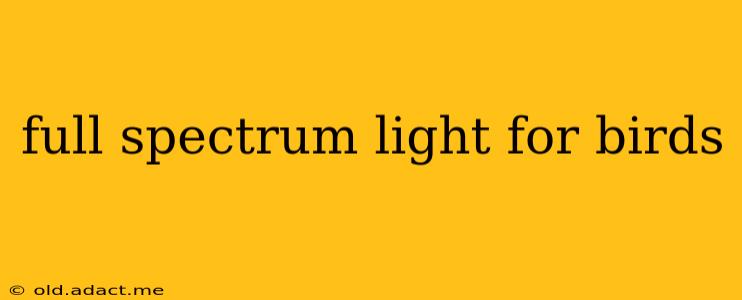Full-spectrum lighting is becoming increasingly popular among bird owners, but understanding its benefits and drawbacks is crucial for responsible avian care. This guide delves into the importance of appropriate lighting for birds, exploring the advantages and disadvantages of full-spectrum lighting, addressing common questions, and providing practical tips for optimal avian well-being.
Why is Lighting Important for Birds?
Birds, unlike humans, rely heavily on light for various physiological and psychological processes. Light plays a vital role in their:
- Circadian rhythm: This internal biological clock regulates their sleep-wake cycle, hormone production, and overall health. Inconsistent or inadequate lighting can disrupt this rhythm, leading to stress and health problems.
- Vitamin D3 synthesis: Exposure to ultraviolet (UV) light is essential for birds to produce vitamin D3, a crucial nutrient for calcium absorption and strong bones. A deficiency can cause metabolic bone disease (MBD), a debilitating condition.
- Breeding and molting: Light cycles significantly influence a bird's breeding cycle and molting process. Proper lighting helps ensure successful breeding and healthy feather growth.
- Behavior and mood: Adequate and appropriate lighting can positively impact a bird's behavior and mood, making them more active, engaged, and less prone to stress. A dark environment can lead to lethargy and depression.
What is Full Spectrum Lighting?
Full-spectrum lighting aims to mimic natural sunlight, encompassing the entire visible light spectrum plus UV-A and sometimes UV-B rays. While not identical to sunlight, it offers a broader range of wavelengths than typical incandescent or fluorescent bulbs. Many birds benefit from the increased UV-A and sometimes UV-B, but the appropriate level depends on the specific species.
What are the Benefits of Full Spectrum Lighting for Birds?
- Improved Health: Full-spectrum light aids in vitamin D3 production, supporting bone health and preventing MBD. It also helps regulate the bird's circadian rhythm, leading to improved overall health and well-being.
- Enhanced Mood and Behavior: The closer mimicry of natural sunlight can create a more stimulating and comfortable environment, leading to happier, more active birds.
- Successful Breeding: The proper light cycle is crucial for stimulating breeding behavior and increasing the chances of successful reproduction in many species.
- Healthier Feathers: Adequate UV-A and sometimes UV-B can contribute to healthier feather growth and coloration.
What are the Potential Drawbacks of Full Spectrum Lighting for Birds?
- UV-B Exposure: Excessive UV-B radiation can be harmful to birds. It's vital to choose bulbs with appropriate UV-B output and ensure the bird isn't exposed for excessively long periods. Many experts recommend UV-A only for the majority of companion birds.
- Heat Generation: Some full-spectrum bulbs generate significant heat, which can be uncomfortable or dangerous for birds, particularly in warmer climates. Always monitor the temperature near the bulb.
- Cost: Full-spectrum bulbs are generally more expensive than standard incandescent or fluorescent bulbs.
- Not a Substitute for Natural Sunlight: While beneficial, full-spectrum lighting is not a perfect replacement for natural sunlight and outdoor access (if safe and appropriate for the species).
What Type of Full Spectrum Light is Best for Birds?
The ideal bulb depends on the bird species. Research the specific needs of your bird. Look for bulbs specifically designed for avian use and those with clearly stated UV-A and UV-B output levels. Always prioritize UV-A over UV-B unless specifically recommended for your bird by an avian vet.
How Long Should Birds Be Exposed to Full Spectrum Lighting?
The appropriate lighting duration varies based on the bird species and the time of year. Consult an avian veterinarian or experienced bird breeder for species-specific recommendations. Generally, mimicking natural daylight hours is a good starting point.
Are there any health risks associated with using full-spectrum lighting for birds?
While full spectrum lighting offers several benefits, it's important to avoid excessive exposure to UV-B light. Too much UV-B can cause eye damage and other health problems. Always choose bulbs with appropriate UV-B output and monitor your bird's behavior for any signs of discomfort. It's essential to consult with an avian veterinarian before using any type of full-spectrum lighting to ensure it's appropriate for your bird's specific needs.
Conclusion
Full-spectrum lighting can be a valuable tool for enhancing the well-being of companion birds, but careful consideration of the type of bulb, duration of exposure, and individual bird species needs is crucial. Prioritize consultation with an avian veterinarian to determine the best lighting solution for your feathered friend, ensuring a healthy and happy life.
